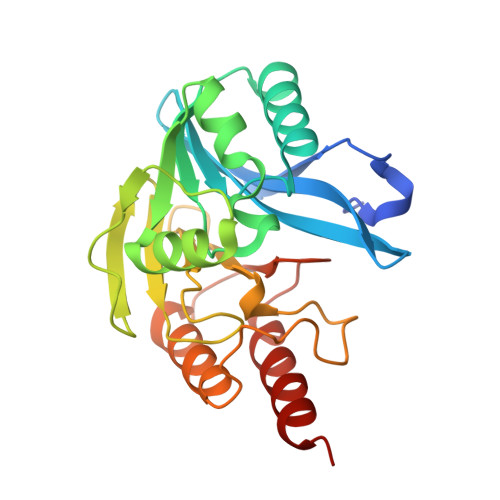Mutation of an active site-adjacent residue in VIM indirectly dictates interactions with and blunts inhibition by D-captopril.
Silwal, S.B., Wamsley, B., Wang, Z., Gung, B.W., Nix, J.C., Page, R.C.(2025) J Inorg Biochem 271: 112975-112975
- PubMed: 40513263
- DOI: https://doi.org/10.1016/j.jinorgbio.2025.112975
- Primary Citation of Related Structures:
9CV1, 9CV2, 9CV3, 9CV4, 9CV5 - PubMed Abstract:
Activity assays and X-ray crystallographic studies were undertaken to elucidate the inhibitory mechanism of captopril stereoisomers on Verona integron-encoded metallo-β-lactamases, specifically VIM-20, VIM-31, and VIM-15. All three VIM-2-like variants (VIM-20, VIM-31, and VIM-15) and VIM-2 expressed in Escherichia coli exhibited catalytic activity with comparable steady-state kinetic parameters. Among the tested thiol drugs (L- and D-captopril, D,L-thiorphan, and 2,3-dimercaprol), IC 50 analyses indicated that D-captopril and 2,3-dimercaprol were more potent inhibitors against the VIM enzymes examined in this study. Notably, the IC 50 value of D-captopril against VIM-31 was an exception, closely resembling that of L-captopril. To elucidate this exceptional inhibitory potency of D-captopril and its binding mode in the active site of VIM-31, high-resolution crystal structures of VIM-20, VIM-31, and VIM-15 in complex with both L- and D-captopril are reported. These findings will help evaluate whether the identified potent inhibitor D-captopril could be further developed as a pan inhibitor targeting the VIM-family enzymes.
- Department of Chemistry and Biochemistry, Miami University, Oxford, OH, USA.
Organizational Affiliation:



















